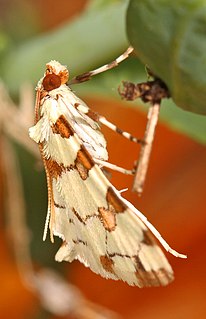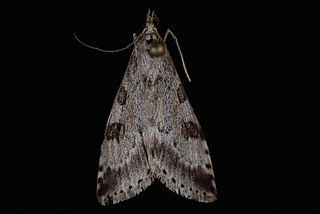Anatralata is a genus of moths of the family Crambidae. It contains only one species, Anatralata versicolor, which is found in North America, where it has been recorded from California to Idaho and British Columbia. The habitat consists of mountainous areas and low-elevation grasslands along the coast of central California.
Dichozoma is a monotypic moth genus of the family Crambidae erected by Eugene G. Munroe in 1961. Its only species, Dichozoma parvipicta, was first described by William Barnes and James Halliday McDunnough in 1918. It is found in North America, where it has been recorded from Arizona, California, Utah and Texas.

Pseudoschinia is a genus of moths of the family Crambidae. It contains only one species, Pseudoschinia elautalis, which is found in North America, where it has been recorded from Arizona, California, Nevada, New Mexico and Texas.
Udea exalbalis is a species of moth in the family Crambidae. It is found in Kazakhstan and Russia, where it has been recorded from the Tula region.
Eudonia torniplagalis is a moth in the family Crambidae. It was described by Harrison Gray Dyar Jr. in 1904. It is found in North America, where it has been recorded from South Dakota, the Rocky Mountains, the mountains of the south-western United States and from British Columbia to southern California.
Scoparia palloralis is a moth in the family Crambidae. It was described by Harrison Gray Dyar Jr. in 1906. It is found in North America, where it has been recorded from British Columbia to southern California, Colorado and western Texas.
Frechinia laetalis is a moth in the family Crambidae. It was described by William Barnes and James Halliday McDunnough in 1914. It is found in North America, where it has been recorded from eastern Washington and Oregon to Utah, southern California and western Texas.

Conchylodes octonalis, the eight-barred lygropia moth, is a snout moth in the family Crambidae. It was described by Zeller in 1873. It is found in North America, where it has been recorded from central and southern California to Texas and from Iowa, Mississippi, Nevada, New Mexico, Oklahoma and Tennessee. The habitat consists of low-elevation arid areas.

Udea itysalis is a moth in the family Crambidae. It was described by Francis Walker in 1859. It is found in North America, where it has been recorded from British Columbia to Quebec, south to Colorado, California, Nevada and Arizona. It has also been recorded from the Sayan Mountains in Russia.
Udea alaskalis is a moth in the family Crambidae. It was described by Arthur Gibson in 1920. It is a high Arctic species found in North America, where it has been recorded from Alaska. It is also found in Greenland and northern European Russia.
Udea amitina is a moth in the family Crambidae. It was described by Arthur Gardiner Butler in 1883. It is found in Chile.

Mnesictena antipodea is a moth in the family Crambidae. It was described by John T. Salmon in 1956. This species is endemic to New Zealand, where it has been recorded from the Antipodes Islands.
Udea berberalis is a moth in the family Crambidae. It was described by William Barnes and James Halliday McDunnough in 1918. It is found in North America, where it has been recorded from California.
Udea indistinctalis is a moth in the family Crambidae. It was described by William Warren in 1892. It is found in North America, where it has been recorded from Alberta, Saskatchewan, Washington and California.
Udea octosignalis is a moth in the family Crambidae. It was described by George Duryea Hulst in 1886. It is found in North America, where it has been recorded from California and Texas.
Udea radiosalis is a moth in the family Crambidae. It was described by Heinrich Benno Möschler in 1883. It is found in North America, where it has been recorded from Alberta, Arizona, California, Montana, Nevada, Newfoundland and Labrador and Utah.
Udea rusticalis is a moth in the family Crambidae. It was described by William Barnes and James Halliday McDunnough in 1914. It is found in North America, where it has been recorded from Arizona.

Udea turmalis is a moth in the family Crambidae. It was described by Augustus Radcliffe Grote in 1881. It is found in North America, where it has been recorded from Alberta, Arizona, British Columbia, California, Colorado, Idaho, Manitoba, Montana, Nevada, New Mexico, Utah and Washington.
Udea vacunalis is a moth in the family Crambidae. It was described by Augustus Radcliffe Grote in 1881. It is found in North America, where it has been recorded from California.

Udea washingtonalis, the Washington udea moth, is a moth in the family Crambidae. It was described by Augustus Radcliffe Grote in 1882. It is found in North America, where it has been recorded from Alaska, British Columbia, California, Montana and Washington.






